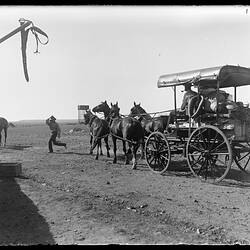Summary
Photograph depicting the start of the Spencer and Gillen, 1901 - 1902 Expedition from Oodnadatta to Borroloola, Walter Baldwin Spencer, the famous founding father of anthropology in Australia, was the second Director of the National Museum of Victoria (now Museums Victoria), from 1899 to 1928. He was invited to participate as zoologist and photographer in the The Horn Scientific Expedition, the first primarily scientific expedition to study the natural history of Central Australia. The expedition took place from May to August 1894. At the end of the Expedition, at Alice Springs in July of 1894, Spencer met Francis J. Gillen, the operator of the Alice Springs Telegraph Station and the South Australian Government Sub-Protector of Aboriginal people. Gillen had for many years maintained an interest in and concern for the Arrernte Aboriginal people. In 1901 Spencer and Gillen set out on an expedition together to study the Arrernte people, and to study other groups between the Arrernte and the north coast. The only other European on the expedition was mounted trooper Chance, appointed by the South Australian Government, whose general handiness in camp, experience of the centre and tact in his relationships with Aboriginal people, made him invaluable. Two Aboriginal men were associated with the expedition for its duration, Erlikiliakirra and Purula. Erlikiliakirra, also known as Warwick, was described by Spencer and Gillen, as 'first rate' and became indispensable as translator. Other Aboriginal men were engaged for specific tasks when the expedition party made extended stays at certain Aboriginal camps.
Physical Description
Silver gelatin emulsion. Quarter plate.
More Information
-
Object/Medium
Glass plate
-
Individuals Identified
Chance, Harry
-
Photographer
-
Locality
-
Date Produced
-
Keywords
People, Transport, Expedition, Technology, Fauna, Topography
-
References
[Book] Batty, Philip, et al. 2005. The Photographs of Baldwin Spencer.
-
Collection Names
-
Type of item
-
Discipline
-
Category
-
Collecting Areas
Ethnohistory, Central and Western and South Australian Ethnographic


